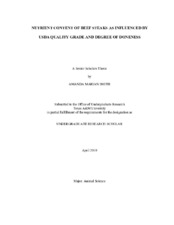Nutrient Content of Beef Steaks as Influenced by USDA Quality Grade and Degree of Doneness
| dc.creator | Smith, Amanda M. | |
| dc.date.accessioned | 2010-07-15T00:17:43Z | |
| dc.date.accessioned | 2010-07-23T21:37:19Z | |
| dc.date.available | 2010-07-15T00:17:43Z | |
| dc.date.available | 2010-07-23T21:37:19Z | |
| dc.date.created | 2010-05 | |
| dc.date.issued | 2010-07-14 | |
| dc.date.submitted | May 2010 | |
| dc.identifier.uri | https://hdl.handle.net/1969.1/ETD-TAMU-2010-05-8098 | |
| dc.description.abstract | The purpose of this study was to determine the influence of various degrees of doneness on the nutrient content of beef. Ten steaks were obtained from each of five USDA Prime, five USDA Choice, and five USDA Select strip loins and assigned to one of five degree of doneness treatments (two sets of treatments per strip loin): uncooked, medium rare (63 °C), medium (71 °C), well done (77 °C), and very well done (82 °C). Steaks then were dissected into separable tissue components consisting of lean, fat, and refuse. Lean tissue was used to obtain proximate analyses of protein, moisture, fat, and ash. This study showed that degree of doneness did influence (P < 0.05) the nutrient composition of beef steaks. As the degree of doneness increased, percent fat and protein increased, while percent moisture decreased. Thus, cooking steaks to a higher degree of doneness will result in a higher calorie steak. | en |
| dc.format.mimetype | application/pdf | |
| dc.language.iso | eng | |
| dc.subject | Degree of doneness | en |
| dc.subject | nutrient content | en |
| dc.subject | Top loin | en |
| dc.title | Nutrient Content of Beef Steaks as Influenced by USDA Quality Grade and Degree of Doneness | en |
| thesis.degree.department | Animal Science | en |
| thesis.degree.discipline | Animal Science | en |
| thesis.degree.grantor | Texas A&M University | en |
| thesis.degree.name | Bachelor of Science | en |
| thesis.degree.level | Thesis | en |
| dc.contributor.committeeMember | Savell, Jeffrey W. | |
| dc.contributor.committeeMember | Harris, Kerri B. | |
| dc.type.genre | thesis | en |
| dc.type.material | text | en |


